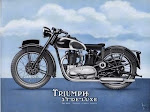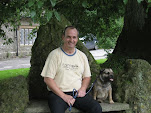Sunday, 25 August 2013
Forks on!
task but the forks are now installed. It started with re-spraying the cowls
as there was a dent in each that I wanted to remove. Then I discovered the
station sliders were threaded at the bottom ends and the bolts had a
shoulder that need to pass through this 'thread'. The securing nut on one
fork - the one that secures the lower bronze bush - was not threaded
correctly but fortunately I had a spare. The drain plug holes were
completely gummed up and the bores had a very difficult to remove sediment
in the bottom (I used carb cleaner to loosen the rubbish). All in all it
probably took me the best part of a day to sort out all of these issues
(whilst trying to sort out the engine cranks....)
Friday, 23 August 2013
Engine bits!
I never realised how complex it could become when I decided to rebuild the crank part of the engine on the 3T.
I must have around 6 engines and all mostly dismantled. Together with spares and suchlike, collected over the years, I have many cranks, rods and flywheels. So you you would think it a simple matter selecting the better components, fitting together and then voila, the bottom end is complete. If only! Most of the parts are of differing diameters and were either ordered as oversize options or have been machined to take up wear! The first engine has ended up with new old stock cranks and rods fitted to a matching flywheel. The second will have the same and the third will have refurbished cranks/rods with new white metal bearings etc. I would have used the flywheel assembly for the first engine but it was kindly pointed out to me that the assembly may not have ever been balanced. Once assembled I may end up getting the flywheel balanced.
So, the engine (lower end) should be together this weekend and I will post a celebratory photo!
Monday, 19 August 2013
Engine update...
I needed to see how the engine would fit together and test the new cam bushes with the camshafts. One was binding completely. So a strip down and a refit and bolt up had the same effect. The only answer would be to get an 13/16" reamer, make a bush and sort the blighter out!
Today I returned to my bench strewn with parts how I left it yesterday in disgust and reassembled it all again – both cams are free! What was that all about? The weather is the same. Maybe there was some dirt in the bushes but I doubt it. Anyway, on to the flywheel now.
I have now, I think, selected the best set of rods and crank arms that have the least wear (excluding ones I have had restored and a complete new assembly) I have had to use one new old stock con rod, a good arm, one new old stock crank (timing side) and a decent con rod. Play is minimal and I only need to check the small rod end of the used con rod before I assemble.
As a point of interest, the NOS crank assembly I have has no balancing drill holes on it, so I suspect this will need balancing if ever used.
Monday, 12 August 2013
Engine progression!
- Mark the cam bushes on the edge with a marker pen to indicate where the oil hole is.
- Do the same on the crank case
- This makes it easy to line up the bushes when fitting
- Put the cam bushes and crank bush into the freezer for half an hour.
- Put the crankcase into the oven for half an hour at 135degC
- When ready remove and place on a couple of blocks.
- Fit crank bush – this should only need minimal force to fit – I use a large wooden block as a drift.
- Fit can bushes – alighning the marks previously made. To drift in, I use an old camshaft as a tool. Again not too much force is required. Make sure all bushes are fully home.
- Make a final check that the oilways line up.
- Same principle was done for the other crankcase – the bearing almost dropped in!













